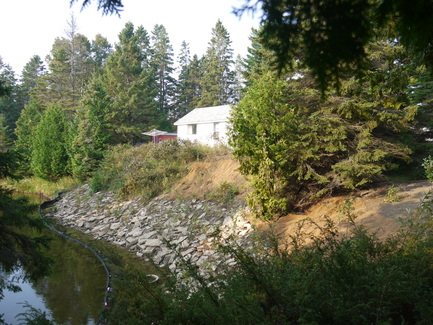Mindemoya River - Site MIN-614

Bank Restoration and Stabilization
This rehabilitation consisted of bank restoration and joint vegetative plantings. Plantings consisted of various local, native shrubs. Soil stabilization consists of coir fabric and ground cover.
All cross sections have been generally constructed to the approved plans. The features and banks were noted to be stable during the site inspection. While no construction occurred within the channel, fish passage is possible and the profile was noted to be generally stable during the site inspection. Flow conditions are varied due to the presence of the local riffles and the pool.
The rehabilitation of site MIN 614 involved the restoration of the following bank features along an approximately 30 m long section of the Mindemoya River:
A total of 180 sq metres of shoreline protected, stabilized improved and/or retired from agricultural use. This project had 7 volunteers from the Board of Directors of Manitoulin Streams participate in planning and actively volunteering at rehabilitation sites. The total number of hours volunteered for this site is 51.4.
A total of 6 other volunteers contributed 36 hours mainly by tree planting and conducting field work. The landowner and family contributed 22 hrs of labour and 4 hrs of attending meetings.
Funding contributions toward the construction of the project include CFWIP, COA and NOHFC.
This rehabilitation consisted of bank restoration and joint vegetative plantings. Plantings consisted of various local, native shrubs. Soil stabilization consists of coir fabric and ground cover.
All cross sections have been generally constructed to the approved plans. The features and banks were noted to be stable during the site inspection. While no construction occurred within the channel, fish passage is possible and the profile was noted to be generally stable during the site inspection. Flow conditions are varied due to the presence of the local riffles and the pool.
The rehabilitation of site MIN 614 involved the restoration of the following bank features along an approximately 30 m long section of the Mindemoya River:
- 180 sq metres of shoreline protected, stabilized improved
- Stone 60 cubic metres
- Potted Shrubs 144
- Seed Mix +/- 195 sq. metres
- Coir Matting +/- 280 sq. metres
A total of 180 sq metres of shoreline protected, stabilized improved and/or retired from agricultural use. This project had 7 volunteers from the Board of Directors of Manitoulin Streams participate in planning and actively volunteering at rehabilitation sites. The total number of hours volunteered for this site is 51.4.
A total of 6 other volunteers contributed 36 hours mainly by tree planting and conducting field work. The landowner and family contributed 22 hrs of labour and 4 hrs of attending meetings.
Funding contributions toward the construction of the project include CFWIP, COA and NOHFC.

